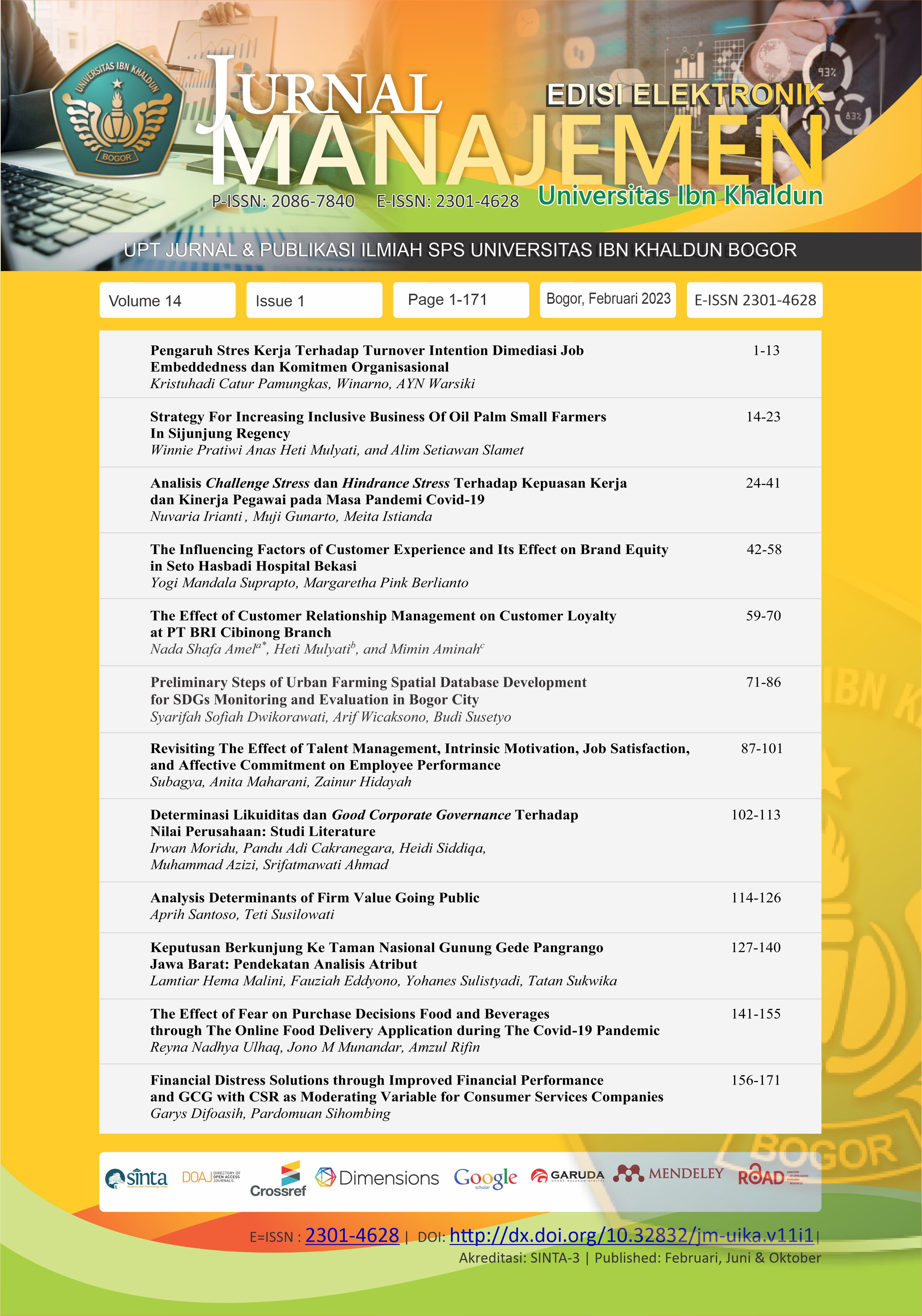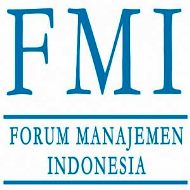Analisis Challenge Stress dan Hindrance Stress Terhadap Kepuasan Kerja dan Kinerja Pegawai Pada Masa Pandemi Covid-19
DOI:
https://doi.org/10.32832/jm-uika.v14i1.8104Keywords:
challenge stressors, hindrance stressors, employee performance, employee satisfaction, work stressAbstract
This article aims to determine the type of stress experienced by employees during the Covid-19 pandemic. Each employee is given a target that must be achieved, while during the Pandemic economic growth is not good. Seeing this phenomenon, there appears a type of stress that can have a positive effect (challage stressor) and a negative effect (hindrance stressor) on employee performance and satisfaction. The methodology used is a quantitative method approach, with a total sample of 350 respondents spread across the island of Sumatra. This research shows that not all stress has a bad impact, but good types of stress are used as opportunities to grow, develop and become triggers to meet targets so as to provide performance and satisfaction. On the other hand, if the stress that arises is used as a burden so that the target is not achieved, and has an impact on low performance and employee satisfaction.References
Avila, M. L., Stinson, J., Kiss, A., Brandí£o, L. R., Uleryk, E., and Feldman, B. M. (2015). A critical review of scoring options for clinical measurement tools. BMC Research Notes, 8(612): 1-11
Aziri, B., 2011. Job satisfaction: a literature review, Management Research And Prac-tice, 3(4), 77-86.
Beehr, T. A. (1985). Organizational stress and employee effectiveness: A job charac-teristics approach. In T. A. Beehr & R. S. Bhagat (Eds.), Human stress and cognition in organizations: An integrated perspective (pp. 57-81). New York: John Wiley & Sons, Inc.
Chin, W. W., B. L. Marcolin, and P. R. Newsted (1995), "A Partial Least Squares La-tent Variable Modeling Approach for Measuring Interaction Effects: Results from A Monte Carlo Simulation Study and Voice Mail Emotion/Adoption Study, "Proceed-ings of The Seventeenth International Conference on Information Systems, pp. 21-41.
Chin, W. W. and P. A. Todd (1995), " On the Use, Usefulness, and Ease of Use of Structural Equation Modeling in MIS Research:A Note of Caution, " MIS Quarterly, Vol. 19, No. 2, pp. 237-246
Chin, W. W. (1998), "The Partial Least Squares Approach to Structural Equation Modeling, "Modern Methods for Business Research, pp. 295-336.
Chin, W. W. (1998). The partial least squares approach for structural equation model-ing. Pp. 295-336 in Macoulides, G. A., ed. Modern methods for business research. Mahwah, NJ: Lawrence Erlbaum Associates.
Chin, Wynne W., & Newsted, P. R. (1999). Structural equation modeling analysis with small samples using partial least squares. Pp. 307-341 in R. H. Hoyle, ed. Statistical strategies for small sample research. Thousand Oaks, CA: Sage Publications.
Chin, W. W., R. A. Peterson, and S. P. Brown (2008), "Structural Equation Modeling in Marketing: Some Practical Reminders, "Journal of Marketing Theory and Practice, Vol. 16, No. 4, pp. 287–298.
Chin, W. W., B. L. Marcolin, and P. R. Newsted (1995), "A Partial Least Squares La-tent Variable Modeling Approach for Measuring Interaction Effects: Results from A Monte Carlo Simulation Study and Voice Mail Emotion/Adoption Study, "Proceed-ings of The Seventeenth International Conference on Information Systems, pp. 21-41.
Chin, W. W.; R. A. Peterson; and S. P. Brown (2008), "Structural Equation Modeling in Marketing: Some Practical Reminders, "Journal of Marketing Theory and Practice, Vol. 16, No. 4, pp. 287–298.
Christoforou, P. S., & Ashforth, B. E. 2015. Revisiting the debate on the relationship between display rules and performance: Considering the explicitness of display rules. Journal of Applied Psychology, 100: 249-261.
Cooper, D. R. and P. S. Schindler (2014), Business Research Methods, 12th ed. New York, NY: McGraw-Hill Companies, Inc.
Cooper, D. R. and and Schindler, P. S. (2019) Business Research Methods. 13th edn. Edited by Hill Irwin. New York: McGraw.
air Jr, J. F., Sarstedt, M., Hopkins, L., & Kuppelwieser, V. G. (2014). Partial least squares structural equation modeling (PLS-SEM) An emerging tool in business re-search. European Business Review, 26(2), 106-121.
Hair, J. F., W. C. Black, B. J. Babin, and R. E.Anderson (2014), Multivariate Data Analysis, 7th ed. Essex, England: Pearson Education Limited.
Hon, A. H. Y., and Kim, T. Y. 2007. Work overload and employee creativity: The roles of goal commitment, task feedback from supervisor, and reward for competence. In Current topics in management, vol. 12, ed. M. A. Rahim, 193-211. New Brunswick: Transaction Publishers.
Hon, A. H. Y., and A. S. M. Leung. 2011. Employee creativity and motivation in the Chinese context: The moderating role of organizational culture. Cornell Hospitality Quarterly 52 (2): 125-34.
Hon, A. H. Y. and Chan, W. W. (2013). The Effects of Group Conflict and Work Stress on Employee Performance. Cornell Hospitality Quarterly, 54(2), 174-184.
Hon, A. H. Y. 2012. Shaping environments conductive to creativity: The role of intrinsic motivation. Cornell Hospitality Quarterly 53 (1): 53-64.
Jex, S. M. (1998). Stress and job performance: Theory, research, and implications for managerial practice. Thousand Oaks, CA: Sage.
Jex, S., & Yankelevich, M. (2008). Work stress. In J. Barling, & C. L. Cooper The SAGE handbook of organizational behavior: Volume I - micro approaches (pp. 498-518). SAGE Publications Ltd, https://www.doi.org/10.4135/9781849200448.n27
Kanyurhi, E. B., & Akonkwa, D. B. M. (2016). Internal marketing, employee job satis-faction, and perceived organizational performance in microfinance institu-tions. International Journal of Bank Marketing.
LePine, J. A., Podsakoff, N. P., & LePine, M. A. (2005). A meta-analytic test of the challenge stressor hindrance stressor framework: An explanation for inconsistent rela-tionships among stressors and performance. Academy of Management Journal, 48, 764–775.
LePine, M. A., Zhang, Y., Crawford, E. R., & Rich, B. L. (2016). Turning their pain to gain: Charismatic leader influence on follower stress appraisal and job performance. Academy of Management Journal, 59(3), 1036-1059. https://doi.org/10.5465/amj.2013.0778
MacKenzie, S. B., Podsakoff, P. M., & Jarvis, C. B. (2005). The Problem of Measure-ment Model Misspecification in Behavioral and Organizational Research and Some Recommended Solutions. Journal of Applied Psychology, 90(4), 710–730.
Motowidlo, S. J., Borman, W. C., & Schmit, M. J. (1997). A theory of individual dif-ferences in task and contextual performance. Human Performance, 10, 71–83.
Podsakoff NP, LePine JA and LePine MA (2007) Differential challenge stressor-hindrance stressor relationships with job attitudes, turnover intentions, turnover, and withdrawal behavior: A meta-analysis. Journal of Applied Psychology 92(2): 438–454.
Podsakoff, N. P., LePine, J. A., and LePine, M. A. (2007). Differential challenge stressor-hindrance stressor relationships with job attitudes, turnover intentions, turnover, and withdrawal behavior: A meta-analysis. Journal of Applied Psychology 92:438-54
Rachel Natalya Massie, William A. Areros, and Wehelmina Rumawas. "Pengaruh Stres Kerja Terhadap Kinerja Karyawan Pada Kantor Pengelola It Center Manado.” Jurnal Administrasi Bisnis, vol. 6, no. 2, 2018, pp. 1–49, doi:10.35797/jab.6.002.2018.19851.
Robbins, S. P. and Judge, T. A. (2013). Organizational Behavior. 15th ed. Upper Saddle River, New Jersey: Prentice Hall.
Robbins, S.P. and Judge, T.A. (2013) Organisational Behavior. 15th edition, Pearson, Boston.
Rodell, J. B., & Judge, T. A. (2009). Can "good” stressors spark "bad” behaviors? The mediating role of emotions in links of challenge and hindrance stressors with citizenship and counterproductive behaviors. Journal of Applied Psychology, 94, 1438-1451.
Rosen, C. C., Chang, C., Djurdjevic, E., & Eatough, E. (2010). Occupational stressors and job performance: An updated review and recommendations. In P. L. Perrewé & D. C. Ganster (Eds.), Research in occupational stress and well-being, Vol. 8, New devel-opments in theoretical and conceptual approaches to job stress (pp. 1–60). Bingley, UK: Emerald Group.
Saunila, M., Rantala, T., & Ukko, J. (2017). Characteristics of customer value creation in digital services. Journal of Service Science Research, 9(2), 239-258.
Sekaran, U. and R. Bougie (2010), Research Methods for Business: A Skill Building Approach, West Sussex, United Kingdom: John Wiley & Sons, Ltd.
Siyoto, Sandu, and Muhammad Ali Sodik (2015).” Dasar metodologi penelitian. Lit-erasi Media Publishing”.
Williams, L. J., and S. E. Anderson. 1991. Job satisfaction and organizational commitment as predictors of organizational citizenship and in-role behavior. Journal of Management 17:601-17.
Downloads
Published
How to Cite
Issue
Section
License
Authors who publish with this journal agree to the following terms:
- Authors retain copyright and grant the journal right of first publication with the work simultaneously licensed under a Creative Commons Attribution-NonCommercial-ShareAlike 4.0 International License that allows others to share the work with an acknowledgement of the work's authorship and initial publication in this journal.
- Authors can enter into separate, additional contractual arrangements for the non-exclusive distribution of the journal's published version of the work (e.g., post it to an institutional repository or publish it in a book), with an acknowledgement of its initial publication in this journal.
- Authors are permitted and encouraged to post their work online (e.g., in institutional repositories or on their website) prior to and during the submission process, as it can lead to productive exchanges, as well as earlier and greater citation of published work (See The Effect of Open Access).











